
German postcard by Ufa, Berlin-Tempelhoff, no. CK-170. Photo: Klaus Collignon / Ufa. Publicity still for Das Mädchen Rosemarie/The Girl Rosemarie (Rolf Thiele, 1958).
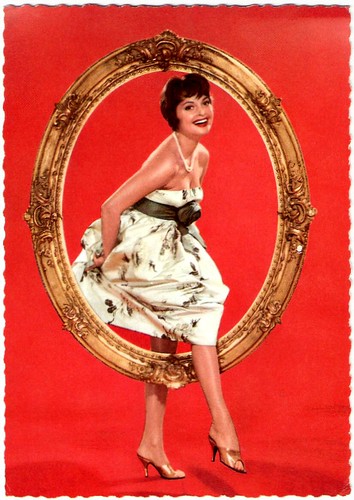
German postcard by Ufa, Berlin-Tempelhoff, no. CK 216. Photo: Klaus Collignon / Ufa.

German postcard by WS-Druck, Wanne-Eickel, no. F 46. Photo: Klaus Collignon.
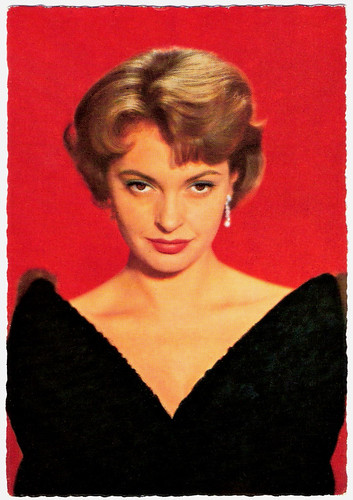
German postcard by WS-Druck, Wanne-Eickel, no. F 136. Photo: DEB-Paris.
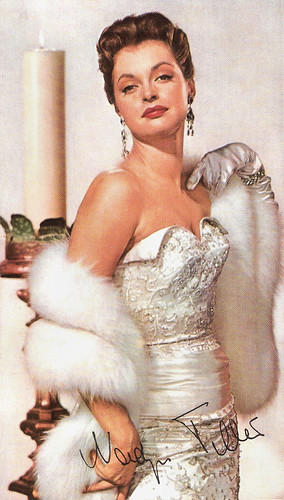
German promotion card for Luxor.
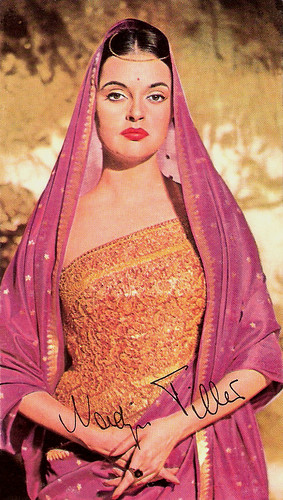
German promotion card for Lux Soap.
Miss Austria
Maria Nadja Tiller was born into a theatrical family in Vienna, Austria, in 1929. Her parents were the actor Anton Tiller and the operetta singer and actress Erika Körner.
From 1945 on, she studied at the Max-Reinhardt-Seminar and till 1949 at the Musik- und Schauspielakademie. She got an engagement at the Theater in der Josefstadt.
Meanwhile, she also worked as a model, and won the Miss Austria contest twice, in 1949 and 1951. The Miss Austria title caused her dismissal at the Theater in der Josefstadt, but it turned out to be her ticket into filmmaking.
In 1949, she acted opposite O.W. Fischer in Märchen vom Glück/Kiss Me Casanova (Arthur de Glahs, 1949). Many roles as a vamp in German and Austrian light entertainment films followed.
In 1954 she worked with director Rolf Thiele in the successful romantic comedy Sie/She with Marina Vlady. Her next film for Thiele, Die Barrings/The Barrings (1955) with Dieter Borsche, became her artistic breakthrough. Until 1970 Thiele and Tiller would make eleven films together, including Friederike von Barring (1956) and Lulu/No Orchids for Lulu (1962), with Mario Adorf.
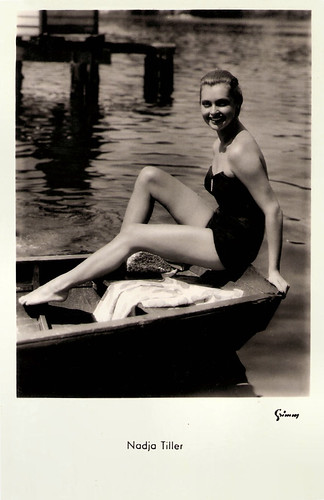
French postcard by Editions P.I., Paris, no. FK 3814. Photo: Arthur Grimm / Ufa.
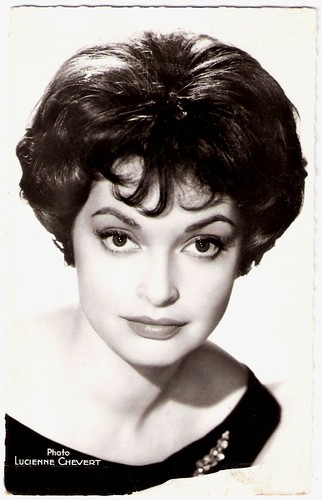
French postcard by Editions du Globe (E.D.U.G.), Paris, no. 812. Photo: Lucienne Chevert.
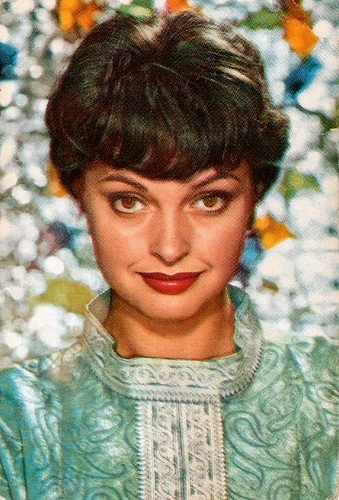
Belgian collectors card, no. 81. Photo: Klaus Collignon.
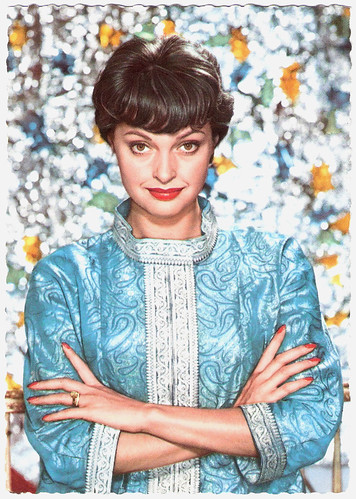
German postcard by Ufa, Berlin-Tempelhof, no. CK-215. Photo: Klaus Collignon / Ufa.
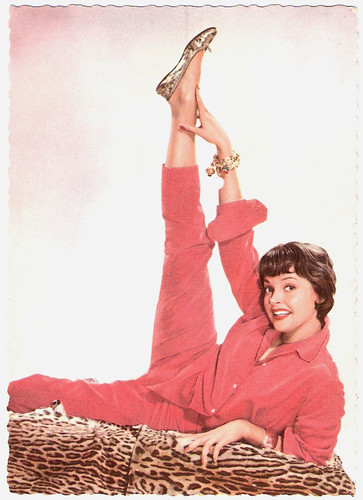
German postcard by Ufa, Berlin-Tempelhof, no. CK-205. Photo: Klaus Collignon / Ufa.
Nadja Tiller’s international breakthrough role was that of the high-class prostitute Rosemarie Nitribitt in Das Mädchen Rosemarie/Rosemary (Rolf Thiele, 1958). The film, based on a murder scandal of the year before, was a huge, international success. It confirmed the assumption of post-war, American audiences that European actresses were somehow more sensuous and erotic than their Hollywood counterparts.
Tiller won the Best Actress award at the Film Festival of Venice for the role. There she was offered roles in Antonioni's La Notte (1961), Fellini's La dolce vita (1960), and Visconti's Rocco e i suoi fratelli/Rocco and his Brothers (1960), but she had to decline all three for familiar reasons. She was pregnant.
Later she would appear at the side of such international stars as Jean Gabin, Jean-Paul Belmondo, Rod Steiger, Yul Brynner and Michael Caine, but it did never bring her the status that she could have had with the three roles she had to say no to.
She did appear in the international productions The Rough and the Smooth (Robert Siodmak, 1959), Du Rififi chez les femmes/Rififi Among the Women (Alex Joffé, 1959) with Robert Hossein, An einem Freitag um halb zwölf/On Friday at Eleven (Alvin Rakoff, 1961), L'Affaire Nina B./The Nina B. Affair (Robert Siodmak, 1961), the thriller La chambre ardente/The Burning Court (Julien Duvivier, 1962), and Anima nera/Black Soul (Roberto Rossellini, 1962) with Vittorio Gassman, and she stayed popular among the art house public.

German postcard by Ufa (Universum-Film Aktiengesellschaft), Berlin-Tempelhof, no. CK-123. Photo: Arthur Grimm / Ufa.

West German postcard by Ufa/Film-Foto, Berlin-Tempelhof, no. FK 1778. Photo: Arthur Grimm / CCC-Film / Herzog Film.
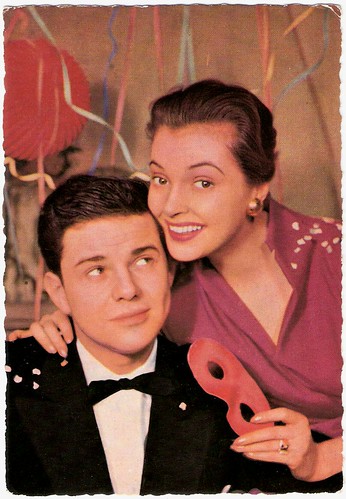
With husband Walter Giller. German postcard by WS-Druck, Wanne-Eickel, no. F 47. Photo: Huster.
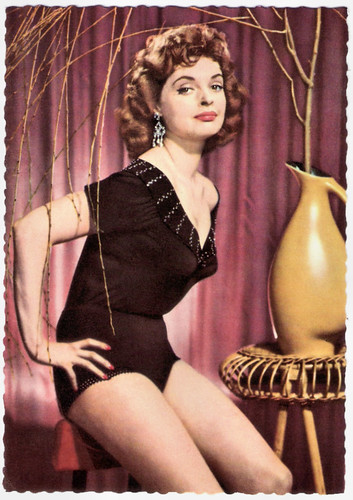
German postcard by Ufa, Berlin-Tempelhof, no. CK-14. Photo: Arthur Grimm.
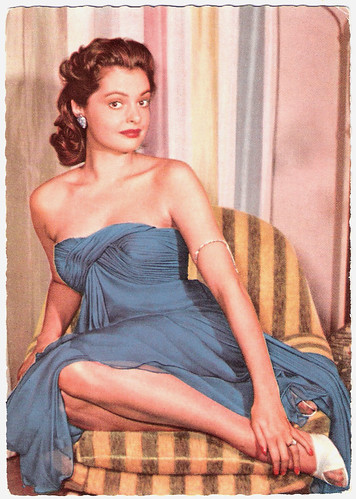
German postcard by Ufa, Berlin-Tempelhof, no. CK-106. Photo: Eberhardt Schmidt / Ufa.
Nadja Tiller acted in more than 70 films, but since the 1970s she works mainly in theatre and television. During the 1970s and 1980s, she worked for theatres in Lübeck, Berlin and Vienna. A great success was her leading role in the Kurt Weill musical Lady in the Dark.
In 1997 she appeared at the Hamburger Kammerspielen as the elder Hollywood diva Joan Crawford in the play Nächte mit Joan (Nights with Joan) by Cas Enklaar. A year later she also starred in the TV adaptation directed by Horst Königstein with Rita Tushingham as Bette Davis.
Her most recent feature films were the Road movie Barfuss/Barefoot (Til Schweiger, 2005) in which she played the mother of the main character played by director Til Schweiger himself, and the crime comedy Dinosaurier/Dinosaurs (Leander Haussmann, 2009) with Eva-Maria Hagen.
In 1956, Nadja Tiller married actor Walter Giller, whom she had met at the set of the music film Schlagerparade/Hit Parade (Erik Ode, 1953). They were called the 'Traumpaar der Wirtschaftswunder-Ära' (Dream Couple of the Wirtschaftswunder era) in the 1950s and often worked together. They had two children, Natascha (1959) and Jan-Claudius (1964).
Nadja Tiller was honoured with many awards, including the Bundesverdienstkreuz (Germany's Cross of Merit) in 2000. Together with her husband, she received a Bambi Lifetime Achievement Award in 2005. Giller died of cancer in 2011, at the age of 84. From then on, Nadja Tiller lived in a retirement home in Hamburg. There, she passed away twelve years later, at the age of 93. Nadja Tiller acted in more than 70 films.
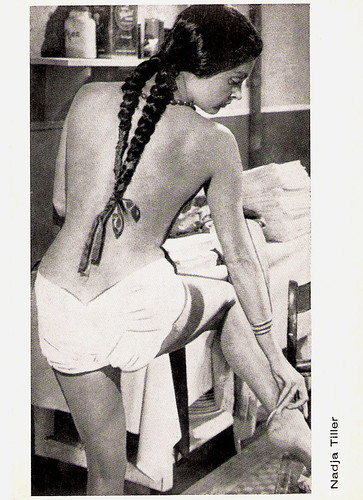
Vintage card.
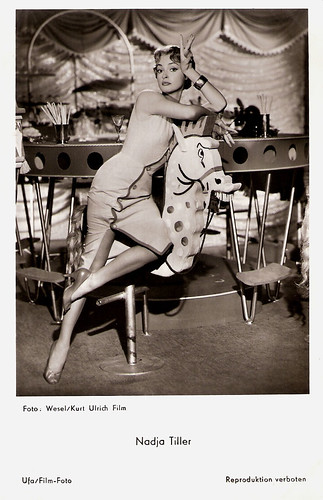
German postcard by Universum-Film Aktiengesellschaft (Ufa), Berlin-Tempelhof, no. FK 3842. Retail price: 25 Pfg. Photo: Wesel / Kurt Ulrich Film. Publicity still for 3 Mann auf einem Pferd/Three Men on a Horse (Kurt Meisel, 1957).

West German postcard by Vereinigte Verlagsgesellschaften Franke & Co, München, no. 93. Photo: Orex / Prisma. Nadja Tiller in Le désordre et la nuit/Night Affair (Gilles Grangier, 1958).

Belgian press photo. Nadja Tiller in Lulu/No Orchids for Lulu (Rolf Thiele, 1962).

Belgian press photo. Nadja Tiller and Leon Askin in Lulu/No Orchids for Lulu (Rolf Thiele, 1962).
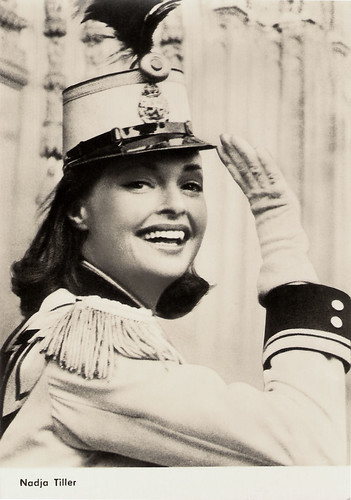
East-German postcard by VEB Progress Film-Vertrieb, Berlin, no. 2476, 1965.
Sources: Dieter Bartetzko (Frankfurter Allgemeine - German), Christian Schröder (Der Tagesspiegel - German), Stephanie D'heil (Steffi-line -German), Filmportal.de (German), IMDb, and Wikipedia.
In 1949, she acted opposite O.W. Fischer in Märchen vom Glück/Kiss Me Casanova (Arthur de Glahs, 1949). Many roles as a vamp in German and Austrian light entertainment films followed.
In 1954 she worked with director Rolf Thiele in the successful romantic comedy Sie/She with Marina Vlady. Her next film for Thiele, Die Barrings/The Barrings (1955) with Dieter Borsche, became her artistic breakthrough. Until 1970 Thiele and Tiller would make eleven films together, including Friederike von Barring (1956) and Lulu/No Orchids for Lulu (1962), with Mario Adorf.

French postcard by Editions P.I., Paris, no. FK 3814. Photo: Arthur Grimm / Ufa.

French postcard by Editions du Globe (E.D.U.G.), Paris, no. 812. Photo: Lucienne Chevert.

Belgian collectors card, no. 81. Photo: Klaus Collignon.

German postcard by Ufa, Berlin-Tempelhof, no. CK-215. Photo: Klaus Collignon / Ufa.

German postcard by Ufa, Berlin-Tempelhof, no. CK-205. Photo: Klaus Collignon / Ufa.
Scandal
Nadja Tiller’s international breakthrough role was that of the high-class prostitute Rosemarie Nitribitt in Das Mädchen Rosemarie/Rosemary (Rolf Thiele, 1958). The film, based on a murder scandal of the year before, was a huge, international success. It confirmed the assumption of post-war, American audiences that European actresses were somehow more sensuous and erotic than their Hollywood counterparts.
Tiller won the Best Actress award at the Film Festival of Venice for the role. There she was offered roles in Antonioni's La Notte (1961), Fellini's La dolce vita (1960), and Visconti's Rocco e i suoi fratelli/Rocco and his Brothers (1960), but she had to decline all three for familiar reasons. She was pregnant.
Later she would appear at the side of such international stars as Jean Gabin, Jean-Paul Belmondo, Rod Steiger, Yul Brynner and Michael Caine, but it did never bring her the status that she could have had with the three roles she had to say no to.
She did appear in the international productions The Rough and the Smooth (Robert Siodmak, 1959), Du Rififi chez les femmes/Rififi Among the Women (Alex Joffé, 1959) with Robert Hossein, An einem Freitag um halb zwölf/On Friday at Eleven (Alvin Rakoff, 1961), L'Affaire Nina B./The Nina B. Affair (Robert Siodmak, 1961), the thriller La chambre ardente/The Burning Court (Julien Duvivier, 1962), and Anima nera/Black Soul (Roberto Rossellini, 1962) with Vittorio Gassman, and she stayed popular among the art house public.

German postcard by Ufa (Universum-Film Aktiengesellschaft), Berlin-Tempelhof, no. CK-123. Photo: Arthur Grimm / Ufa.

West German postcard by Ufa/Film-Foto, Berlin-Tempelhof, no. FK 1778. Photo: Arthur Grimm / CCC-Film / Herzog Film.

With husband Walter Giller. German postcard by WS-Druck, Wanne-Eickel, no. F 47. Photo: Huster.

German postcard by Ufa, Berlin-Tempelhof, no. CK-14. Photo: Arthur Grimm.

German postcard by Ufa, Berlin-Tempelhof, no. CK-106. Photo: Eberhardt Schmidt / Ufa.
Traumpaar
Nadja Tiller acted in more than 70 films, but since the 1970s she works mainly in theatre and television. During the 1970s and 1980s, she worked for theatres in Lübeck, Berlin and Vienna. A great success was her leading role in the Kurt Weill musical Lady in the Dark.
In 1997 she appeared at the Hamburger Kammerspielen as the elder Hollywood diva Joan Crawford in the play Nächte mit Joan (Nights with Joan) by Cas Enklaar. A year later she also starred in the TV adaptation directed by Horst Königstein with Rita Tushingham as Bette Davis.
Her most recent feature films were the Road movie Barfuss/Barefoot (Til Schweiger, 2005) in which she played the mother of the main character played by director Til Schweiger himself, and the crime comedy Dinosaurier/Dinosaurs (Leander Haussmann, 2009) with Eva-Maria Hagen.
In 1956, Nadja Tiller married actor Walter Giller, whom she had met at the set of the music film Schlagerparade/Hit Parade (Erik Ode, 1953). They were called the 'Traumpaar der Wirtschaftswunder-Ära' (Dream Couple of the Wirtschaftswunder era) in the 1950s and often worked together. They had two children, Natascha (1959) and Jan-Claudius (1964).
Nadja Tiller was honoured with many awards, including the Bundesverdienstkreuz (Germany's Cross of Merit) in 2000. Together with her husband, she received a Bambi Lifetime Achievement Award in 2005. Giller died of cancer in 2011, at the age of 84. From then on, Nadja Tiller lived in a retirement home in Hamburg. There, she passed away twelve years later, at the age of 93. Nadja Tiller acted in more than 70 films.

Vintage card.

German postcard by Universum-Film Aktiengesellschaft (Ufa), Berlin-Tempelhof, no. FK 3842. Retail price: 25 Pfg. Photo: Wesel / Kurt Ulrich Film. Publicity still for 3 Mann auf einem Pferd/Three Men on a Horse (Kurt Meisel, 1957).

West German postcard by Vereinigte Verlagsgesellschaften Franke & Co, München, no. 93. Photo: Orex / Prisma. Nadja Tiller in Le désordre et la nuit/Night Affair (Gilles Grangier, 1958).

Belgian press photo. Nadja Tiller in Lulu/No Orchids for Lulu (Rolf Thiele, 1962).

Belgian press photo. Nadja Tiller and Leon Askin in Lulu/No Orchids for Lulu (Rolf Thiele, 1962).

East-German postcard by VEB Progress Film-Vertrieb, Berlin, no. 2476, 1965.
Sources: Dieter Bartetzko (Frankfurter Allgemeine - German), Christian Schröder (Der Tagesspiegel - German), Stephanie D'heil (Steffi-line -German), Filmportal.de (German), IMDb, and Wikipedia.
No comments:
Post a Comment